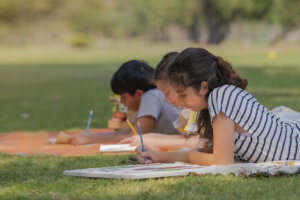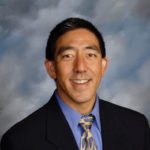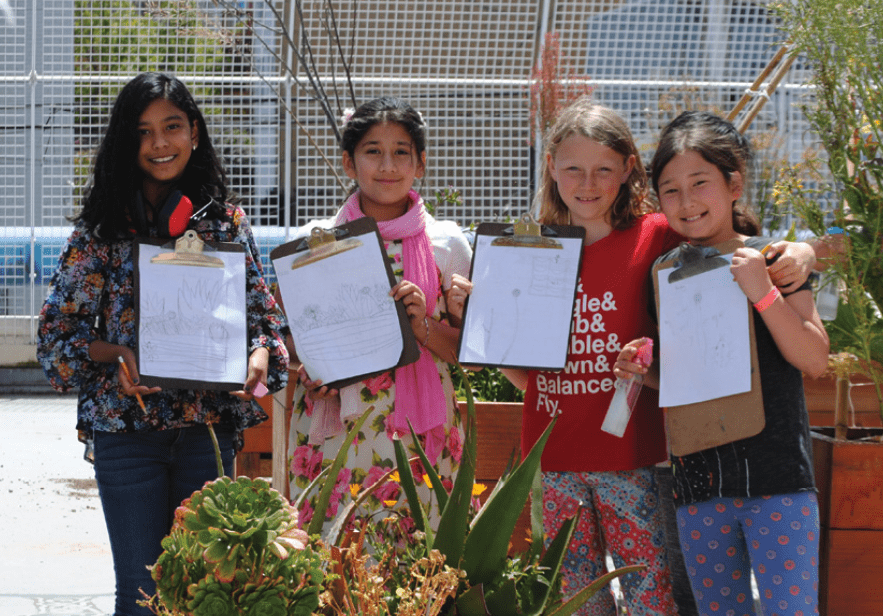Since the launch of CAELI’s Innovation Hubs, leaders across California have used the network to collaborate and grow a community of teachers and administrators committed to creating equitable access to environmental education. With a diverse leadership collaborating within CAELI’s expanding membership, we welcome leaders from various roles in education to create systemic change for California’s 6.2 million public school students.
Nathan Inouye is the science coordinator for Ventura County Office of Education and has been an educator for more than 20 years. Kate Bilse is a Maker Fellow with AmeriCorps VISTA and works with the Ventura County Office of Education to promote environmental literacy and green schools. Together, Nathan and Kate led the Ventura County Office of Education to join the CAELI COE Innovation Hub, where they have fostered a strong network of community partners taking part in green school initiatives and promoting science education.
How have you seen your work grow and develop?
Nathan: I’m a product of outdoor education, so I’ve always had primary experience knowing that outdoor education makes a difference. When I began working with the County Office of Education, I brought and sustained relationships with several community-based partners. We convened a meeting where our teachers and students could meet the community-based partners in environmental education, which helped connect our educators with our Next Generation Science Standards (NGSS) leadership network. Then we applied for the Maker Fellow program from AmeriCorps, where I met Kate Bilse, who joined our team to advocate for environmental literacy and education. With her help, we expanded our capacity to foster relationships with community partners.
Kate: It’s been great to see our environmental educators’ network grow over time with different organizations that focus on marine systems, agriculture, land resources, wildlife, etc. It’s helped open my eyes to the diversity of environmental education programs offered in Ventura County. Now, we’re connecting with schools and districts through our Green Schools Initiatives to help promote sustainability so students can have environmental education opportunities while they connect with their community and use their school grounds as a learning laboratory for green school investigations.
You’ve focused recent environmental education efforts on the Green Ribbon Schools program. Why is that important to you?
Kate: Nathan and I helped two schools submit their Green Ribbon Schools application this past year. We want to try and get the word out to every school in every district in Ventura County, and see more people in our area applying for this award. We hope this will have a ripple effect and we’ll see more and more schools do this.
Nathan: When we look at the Green Ribbon Schools program, it’s not about trying to receive an award. It is about the sustainability of our schools, students, and communities. Through the program, we look at the school infrastructure, the mental health of our students, and environmental education and literacy. When we talk about the big vision, we’re using it as a reflective tool to help engage our schools in conversation about how we continue to grow and become more sustainable.
It seems that environmental education often helps highlight environmental equity. Have you seen that play out in your work?
Nathan: Yes, here is an example. We have a high school located at the edges of an agricultural field and a group of students there wondered, what’s our water quality? In their research, they discovered the local water quality was being affected by the pesticides right next to the school. And so they’ve been having conversations with the farmers about their practices. It’s really engaged a conversation around how close a school should be and what agricultural practices exist. And it’s been very productive because it’s the voices of kids. It’s hard to walk away from that. And it brought some media attention as well. They’re continuing that cause.
How has collaborating with CAELI enhanced the work you’re doing in Ventura County?
Nathan: Being a part of the CAELI Innovation Hub network expanded our connections with other organizations working in environmental education and helped foster collaboration. We have been able to find resources and partners easily through the network, which helps us assist Green Ribbon Schools and other education leaders working toward meeting specific sustainability goals.
Kate: It’s helpful how we are a part of a statewide network promoting environmental literacy because we can learn and share best practices from other leaders. In particular, we used the Community-Based Partner Network Toolkit to help grow our local network. The Innovation Hub has helped us develop our environmental literacy landscape survey by allowing us to see how other surveys are done. Nathan and I have been able to create our own survey that suits teachers’ and administrators’ needs.
You both had a hand in helping develop the Community-Based Partner Network Toolkit. Why is creating more equitable education systems that teach environmental literacy important?
Nathan: Part of our work in helping create the toolkit was implementing it into practice. We were both piloting and providing feedback to the toolkit at the same time. For example, one of the things we used from the toolkit was the self-assessment tool for our network. In our Central Coast Environmental Education Partnership, we realized that we hadn’t ever defined what equity or environmental justice meant for us. To continue growing and building a more robust network that centers equity, we used the toolkit to help facilitate that conversation.
Kate: Through the equity component of the toolkit, we reached out to local organizations to speak at our environmental convening. We invited a local organization called the MERITO Foundation to talk about cultural relevance in environmental education. The toolkit also helped guide me to reach out to everyone in our network to identify bilingual programs and resources for the Spanish-speaking community.
What are your hopes for the future in Ventura county? How are you hoping CAELI’s Innovation Hubs will influence environmental education across the state?
Nathan: I hope we can continue to support our local districts and schools to become more environmentally sustainable to improve learning conditions and academic success. We can hold conversations about why schools should switch to renewable energy through these conversations. I hope to see more strategies around various sustainability efforts that schools can become involved in, which can’t happen without access to a statewide network facilitated through CAELI’s Innovation Hubs to foster relationships. I would like to see every school participate in the Green Ribbon program, not for the award but for the work it engages them in. Many things distract us from nurturing a long-term vision, but being a part of the CAELI community keeps members inspired and renewed toward a vision committed to environmental literacy for students.
Kate: It would be great to see more professional development with teachers about service-learning to expose students to real-world applications of environmental education. It would help them envision a science, STEM, or environmental education career. The more exposure we can give students to the green economy and jobs, the more hope we have for an equitable future that is sustainable for us and our planet.
Nathan: The great thing about the people you meet through the CAELI community is the expertise and experience that many people bring. I recognize that we’re deepening our work standing on the shoulders of others who’ve done this work in the past, probably in more isolation than what I’ve experienced. The CAELI network made me realize the number of people who are committed to this work and have been for many years. Meeting these people is inspiring and energizes my passion for my work.








